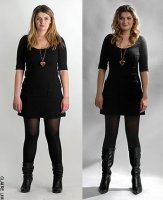 The Telegraph UK has an interesting article talking about how everyone from the kid next door to Hollywood celebrities are getting work done on their photographs.
The Telegraph UK has an interesting article talking about how everyone from the kid next door to Hollywood celebrities are getting work done on their photographs.
The manipulation of photos is a given in the image-is-everything world of celebrity. Earlier this week, the Duchess of York appeared in Italian Vogue. With a tiny waist, sculptured cheekbones and a wrinkle-free face, she bore no relation to the frumpy Fergie who looked every one of her 47 years when papped out jogging recently.
The author theorizes that social networking services like Facebook are partially responsible. That users of those services want to look as attractive as possible to other members and that they are willing to pay to do so.
Personally I have retouched portraits of clients, friends and family. I think it’s possible to make flattering alterations without being false. Technique, camera angle, lighting, 12 megapixel clarity and a dozen other factors all contribute to images that may be technically “true” but neglect the fact that our eyes and brain don’t work that way. That human vision is colored by memory and attention and feeling. In a real sense, altering a photo to reflect that is more real than real, if you get my drift.
But I don’t alter photos to the extent described in this article. And I’m sure you’ve all seen the plastic, lifeless doll children that some people think are beautiful. That’s just creepy as hell.
What’s your opinion on retouching portraits?









I think minor retouches are okay, but a total makeover (as above) is just creating an entirely new person.
As you said, a lot can be done with lighting, composition and cropping to help in the first place.
I have, at my wife’s request, given her virtual breast-reduction surgery in some shots of her that were shared with family. I’ve also removed skin discolorations, smoothed wrinkle lines (NOT totally removed) and lightened bags under eyes. I think these changes match your theme that people have memories about how others look, so I’m returning the person to the way others remember them, thinner, fewer wrinkles, etc.
But I wouldn’t try to remove 40 extra pounds, increase bust size, make them look 20 years younger, etc.
I guess it all depends on what the photographer is trying to accomplish. Is this an “art” piece where someone will look at it and know instantly that it was retouched? If so, then go for it. Photoshop artists are artists too. However, if you’re trying to pass off a retouched photo as reality then I think that’s a bit wrong. A little retouching is OK, but making it so that you can’t recognize the person in the picture unless you’re told who they are is something else entirely
Most people are three dimensional.
Most photographs, retouched or otherwise, are two dimensional.
Most people reflect different visible colors.
Some photographs show only values of black/white.
Some photographs record parts of the electromagnetic spectrum not visible to the the naked eye (infrared light, polarized visible light, etc…)
Most people have features with particular measurements that don’t change.
Any photograph can be shown at any size.
Much depends on the intent of the photographer, but traditionally, portraits have always exaggerated, eliminated or abstracted features of the subject.